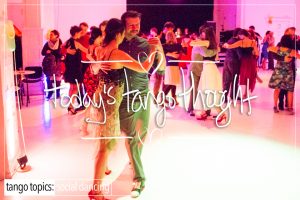Today’s Tango Thought is meant to act as a very brief summary as to where to dance, and what to expect while dancing in New York City.
Before we get into the “List” of where to go. There are a few things to note about dancing in NYC that you need to know going in. In many ways dancing in NY is a lot like dancing in Berlin in terms of attitude. On the surface the two cities are large metro areas, they have very large tango communities, there are a lot of visiting instructors passing through at any one time, there’s a large weekly or nightly social dancing going on, and last but not least there’s lots to see and do that has nothing to do with Tango. All of this is true of Berlin and NYC. However, that’s about where the similarities between the two stop.
Let’s get to the thing that you’ve probably heard from nearly everyone that’s visited NYC for tango: Some have reported that dancing there can make you feel invisible; or “Unless you know someone in the room, you’re more than likely going to sit.”; or “These folks can seem very intimidating!”. So what’s the truth ? It really depends on a few factors. 1.) How well you’re known in the tango world. 2.) How ‘good’ you are. Which is subjective at best. 3.) How you present when dancing (meaning how good you look when dancing, your dancing lines, not your clothes). 4.) How good your social skills are. Each one of those factors can and does create an experience that in NYC can make or break your time there.
The reason this is stated is that you have no illusions about what you’re dancing into. From a pop-culture perspective NY’ers have a reputation for being rude. But if you dig a little deeper than what you’ve heard or read, you’ll find that they’re just like everyone else. They’re nice people if you sit and talk with them. And that’s the key to dancing in NYC with any level of success. Get to know your potential dancing partners. Get involved in them. Ask questions. Get to know them. They can be a little standoffish at first, but for the most part, strike up a conversation and say “hello”. If that doesn’t work, don’t take offense to it. Seriously. They take a little while to warm up to strangers, they do need to see you dance before they’ll take a chance, especially the more experienced dancers, because you never know who or what you’re talking to and what they’re capable of. Not to worry, they’ll come around…eventually.
Some Advice
The great mitigator of any conversation where Tango is the central reason why you’re standing there talking to someone in the first place is not because of their perfume, or their shoes, or what they’re wearing. No. It is your ability to dance and to dance well! In NYC, like in other places, this is the thing that they’re looking for. A ‘good’ dancer. One that not only can visualize and embody the music, but interpret that music, while at the same time also one who looks good (upright posture, no strange embrace postures, or strange hand or arm positions – the iconic visual embrace is a good starting point), and makes their partners look good. They want a quality embrace that doesn’t compress or push, or pull. They want someone that moves well, and is pleasant to dance with. What you’re wearing doesn’t matter. What you have on your feet doesn’t matter. What matters is skill. Pure and simple. Show up and dance well. You’ll get the dances you want (mostly). Dance poorly, by NY standards, and you’re going to have a challenging time getting dances. You do need to be on your game though. What does that mean ? It means don’t mishear this as you have to be perfect. No. Nyet. Perfection not. A ‘Good’ Social Dancer, yes! You do however need to be ‘good’. While ‘good’ is a relative term, there are some things that you should be able to do that are endemic of ‘good’. Walking is first and foremost on that list. Walking cleanly, clearly, and without ‘issues’ is paramount (no thudding, no pushing, no pulling, no hanging…tsk, tsk, tsk). While we can sit here and list a bunch of things that you should be able to do here’s a simple litmus test for both roles: Followers -> Put on your heels, hold a normal embrace, and then walk backwards by yourself as you would normally. If you can do that without wobbling or wavering in any way, shape, or form, at all, you’re on to something. For Leads, your litmus test is -> if you can Lapiz to an Enrosque without wobbling or wavering, you’ve got something. Barring that getting some private lessons before you come to NYC wouldn’t be such a bad idea. That and subscribing to Tango Topics. 😉
The next thing on our list of things to know about NYC Tango is know your music, and know it well. While every milonga has DJs that play a familiar set of songs, what’s happening in most major metro areas is a resurgence of music that doesn’t get played a lot. So musically you want to focus your studies on the Golden Age of Music (1929 – 45). And then be able to interpret that music from a movement perspective. Granted this last item is not going to magically happen overnight. So there are some tools that we have here on TangoTopics to help with that process. Our Musical Interpretation Series as well as our Musical Studies series which is available to all gold and diamond level subscribers.
One last thing: There are several Tango scenes in NYC (Performance/Scenario Tango, Social Tango, Ballroomy Tango, ‘Coolkids’ Tango, Holier-Than-Thou Tango, Outside Tango). And with a few exceptions there is not, sadly, a lot of cross pollination between them. But then again, NY boasts over 20 milongas and practicas a week, and in the summer time there are 4 outdoor Milongas and a few private Milonga/Practica gatherings. It has been said that there are over 500 weekly social dancers out dancing, and another 2000 ppl in the periphery that come and go from the scene. And then there are the visiting instructors that are always passing through, and the Tango travelers from all over the world. And when you put that together with the local dancers from NYC what you get is a rich, diverse, and vibrant dancing scene with lots and lots and lots of variance.
It should be noted that NYC is also very close to New Jersey, and a host of other scenes so there are more dancers out there that visit there from the region especially on certain weekends like for instance “Nocturne” Weekend. This is the weekend that Nocturne Milonga happens. Usually there’s a crowd that comes from as far away as Buffalo, NY Washington, DC, and Boston, MA just to come to Nocturne.
A Few Factors
The Quality of Dance In NYC. Let’s get right to the heart of this: The quality of dance is dependent on where you go, meaning which Milongas and practicas. There is no one Milonga where you’re assured to find the best of the best. It just doesn’t exist. So you really do have to find the venue that works for you. And luckily for you, there are many to choose from. As a helpful side note, believe it or not, some of NYC’s better Milongas aren’t Milongas, but are Practicas. Yes, you read that correctly. Practicas. If you want to have a nice time, some of the weekly Practicas are the North American variety [North American] of Practicas where the atmosphere is quite nice and the people are very friendly. The quality of dance in the room is actually quite good. Like most major metropolitan areas you have a wide cross-section of levels of skill that can seem, at first, intimidating, and overwhelming, while at the same time insanely crazy. You will find every idea, every style, every facet of Argentine Tango in NYC. If you can think of it, if you’ve heard about a particular style, you’ll find it danced there in NYC, and not just one or two people, but more than a few. Which is to say that dancing in NYC is a bit like a box of chocolates. You never know what you’re going to get. It’s a wide cross-section of skills and abilities. You should be able to find a series of dancers that you can dance with that are exceptionally pleasing and many stages beyond what you’re used to. You will find everything that you can imagine there and more. 😉 As always, YMMV.
The Quality and Quantity of Venues. Like most major metropolitan areas where Tango is present, it has more than a milonga or two per week. In NYC’s case, it has a thriving Milonga scene which can seem dizzying and confusing. However a simple question to who you’re currently dancing with, they’ll give you the lay of the land of where they’re going and what’s good.
How many venues does NYC have ? Lots. And not all the same. There are some cities where the Milongas use the same venues and just change the name of the event but use the same venue over and over again. This does happen in NYC because space and rental of space are at a premium as you might imagine. However, most of the events on the list are in different places with vastly different resources attached or nearby. Some for the better and some not.
The quality of those venues does not disappoint either. They’re all good, clean, clear, consistent dance floors environments. Nice atmosphere, and spaces that you want to dance in/on/at. 😉
EU Residents: Nearly all venues do not serve beer or wine. They’re not allowed to unless they have a liquor license and those things are rare and expensive for a venue to get. So do not expect to have a glass of whatever when you’re dancing. Unless the venue is a bar/restaurant. There are a few, very few, exceptions to this, but for the most part, don’t expect to have a glass of something other than water with your dancing. The venues themselves are good spaces comparable to something you’re used to in the EU. Some events do allow you to bring your own, check with the organizer ahead of time before you go.
Stuff To Be Aware Of
Milonga Closing Times. While this might not be a thing anywhere else in the developed world, in NYC it is a thing. Typically, most Milongas, with the exception of 2 or 3 on the list below, end at about 12:30 or 1am. Very infrequently do they go beyond that with two exceptions, which are noted below. So if you’re looking for late night action because it’s the city that never sleeps, think again. Milongas in NYC do have a stopping point. 🙁 Sadly.
Meals and Food. It goes without saying that there’s a loads of places to eat in NYC. So you shouldn’t have an issue finding somewhere to get a meal. Depending on your budget you can definitely go cheap or go all out. It really depends on what you can afford. Personally, we like to frequent WholeFoods hot bar before an event, and a few late night deli’s for their after-hours food. But that’s just us. That said, there are 3 events on the list below that do serve actual food. Most of the events do have some kind of refreshments which range from water to wine, fruits and bagels to a table with pizza and homemade desserts. However of those 3 events, the All Night Milonga and El Destino are where you can order freshly made Empanadas by Kiya. And the Third is La National‘s Restaurant which is a full-blown restaurant which is pretty good actually. Aside from that, don’t expect wonders of meals. YMMV.
Fees. Expect to pay anywhere between $10 and $20 for the Milonga or Practica. And 10 is being generous these days with space rental being what it is. Which is to say that a lot of Practicas and Milongas have to charge more than 10 dollars just to pay for their space rental fees. There are no other fees associated with getting into the Milongas.
Parking. Ugh. Parking is bad all over. Just know that if you rent or bring your car to NYC that finding parking is not exactly the easiest or the cheapest thing to do. Yes you can get from point a. to point b. quickly but then you have to find parking. Usually you’ll want to find a parking garage near the venue and while there are many of those around, expect to pay a premium for the priv!
Taxis/Uber/Lyft. You could avoid the whole car business by taking an Uber, Lyft, or Taxi just saying. 😉 Uber/Lyft work just fine in NYC.
Transit. NYC has a very robust transit system of trains and buses. It should be noted that nearly all milongas or practicas are easily accessible via the transit system. The only thing you need to do is get a MetroCard, which can be purchased at nearly any subway station, and then filled up as you need to either with time or value. Meaning you can buy it for a day, a week, or a month. Or you can add value of 5, 10, 20, 30, or whatever value you want to the card. We recommend, if you’re going to be there for a long week or weekend, getting the 7 day pass which allows you access to the entire system (minus the path system to NJ). At the time of this writing, it’s $32.00 and worth it. The money you’ll spend on each transit to and from venues as well as transiting around NYC between Milongas can get crazy expensive. As each transit is 2.75 per transit on the entire system. That adds up. So $32.00 begins to look very cheap by comparison.
Tango Resources for NYC
Dancing Resources: Probably the best place to look to see what’s happening is the New York Tango Calendar. This is kept up to date by Gayle Gibbons Madeira. If the event that you thought was happening isn’t on the Calendar, then there are two reasons for that. 1.) It’s a private event. or 2.) It doesn’t exist. [ http://newyorktango.com/ ] It’s always a good idea to check there first and foremost to see what’s going on.
Secondly is obviously Facebook, there are several Facebook Groups for NYC and the dancing scene. Also, generally speaking, most milongas also have their own Facebook pages where they announce their next events. You will find most local events, Milongas, and happenings posted in these groups. Also, it’s a good place to connect with people and find out what’s good that week.
What’s Up Tango > https://www.facebook.com/groups/whatsuptango/
New York Tango News > https://www.facebook.com/groups/nyctangonews/
Tango NYC > https://www.facebook.com/groups/tangowithjon/
New York Tango (2) > https://www.facebook.com/groups/8812028532/
Tango In New Jersey > https://www.facebook.com/groups/tangonj/
Where To Dance ?
Where To Dance: And now to the thing you absolutely want to know. What are our suggestions for places to dance ? Before we get to that…our disclaimer — This list is by no means a complete or comprehensive list. It is a preferential list. Meaning ? That we’ve been there, and danced, and found it to be acceptable. If it’s not on the list it just means that we haven’t been there or we don’t frequent that venue. It is by no means a statement of distaste of the event, the venue, or the organizer. For the full list of NY Tango Events please visit http://newyorktango.com/.
Tango Topics Opinion. First and foremost, this is by no means is this a codified guide of where to dance in NYC. In fact, it may piss off a whole bunch of people simply because it mentions X, Y, or Z or doesn’t. This is just a sampling of dancing in NY for the worldly traveler that is coming to NYC to dance. There are so many Milongas and Events it can seem overwhelming, and you may have a friend of a friend that sort of goes out social dancing but isn’t really involved in the scene. Or know someone that dances regularly in NYC and they’re available to guide you. This is for those folks that have neither. So please, for the love of god if you live in NYC, and you’re reading this, don’t hate, and no nasty emails or facebook msgs of “how dare you….” and whatnot. We will update this as needed as it’s now our home. 😉
Still another idea that comes up in relation to NYC and really any scene that you’re walking into, which is why we mentioned it above, there is a belief that you’ll have to no chance to show yourself off if no one will dance with you. And there’s some validity to this line of reasoning. One way around this self-defeating prophecy has to do with a tool that has been suggested for Female Followers, however, it can be applied to both genders and both roles. Earlier above it was stated that you should get to know your potential dancing partners. Say “hello”. There’s something else there that we didn’t mention and it’s this > Near the end of the conversation say the following words regardless of your age, race, gender, or whatever else you think will stand in your way, “…before I go, if you think of it, and you’re available, near the end of a tanda, I’d like to dance a half-a-song with you!”. What you’re doing is creating an opportunity for them to dance with you on their terms when it’s convenient for them, but note that it’s not for a whole song or the full tanda. This is a good way for them to ‘sample’ your skills and if they like, they’ll ask for another. If not, no harm, no foul and no one is stuck dancing with someone that they have discovered that they don’t like dancing with! Do this with enough people over the course of a night and before you know it, you’ll have to fight them off with a stick!
Still another thing and this is purely a Male to Female dynamic, especially in NYC and really any milonga. Clothes do make the person seem more attractive. So above it was stated that no matter what you’re wearing …. and what matters is skill. The reality is that while the clothes may get you the dance, that’s not what’s going to keep the dance. Skill is what keeps the dance, not what you’re wearing. So think of what you’re wearing as an attraction element. What keeps someone interested is what you’re saying and in this case, that discussion is the dance! 😉
In NYC, there’s a fallacy that the organizers will dance with you, or it would be nice if they did or if they introduced you to someone to dance with. This is not true. It really does depend on the Milonga that you attend. If you tell them that you’re new when you walk in the door, make a point that you’re new and that you don’t know anyone but to ask if there’s anyone that you could introduce you to. This is a good practice no matter what city you’re in.
Something that may have gotten overlooked is that you should come to NYC and dance, at least once or twice. The experience is always invigorating on one level and disheartening on another. Which is to say that if you’re a woman of a certain age, read that as anything over 25, and are looking to dance, you’re going to have issues for all the reasons already discussed in Tango Thoughts (here, here, and here. And not to mention, but we will > here!). If you’re a man over 50 with his gut over his belt, the same thing applies only in the reverse. It’s not unheard of in these large metro areas to go out with a Taxi Dancer which solves the problem nicely of having to deal with getting dances. There are a few in NYC that offer their services and for that, you’ll have to ask around. Or go with someone who knows the scene (that is of the opposite gender) and will dance with you a tanda or two to get you started. It’s always a good idea to go to the class before the Milonga to get know people there. If for no other reason than to break the ice of an unfamiliar Milonga scene. It’s also a good idea to be pleasant, smile a lot, sit where you can be seen at all times, no slumping in your chair. Upright, hyper-aware at all times, always be on the lookout for a Mirada or Cabeceo.
One last thing to keep in mind, and this is true of anywhere that you travel for Tango, NYC especially. Keep your ego in check. Even if you think or believe that you’re jesus h. christ that walks on water as far as Tango is concerned, do not under any circumstances display that. You’re new on the scene. You don’t know anyone in the room. Nothing screams “Screw You!” more than someone’s arrogance of betterment. Which is to say that you need to lower your expectations, and be humble and wait your turn. It’s not your home turf, it’s theirs! So in other words, smile, nod, and be patient.
That said. We hope this summary was helpful in some way for you. Thanks for reading, and as always, we look forward to seeing you in class!











